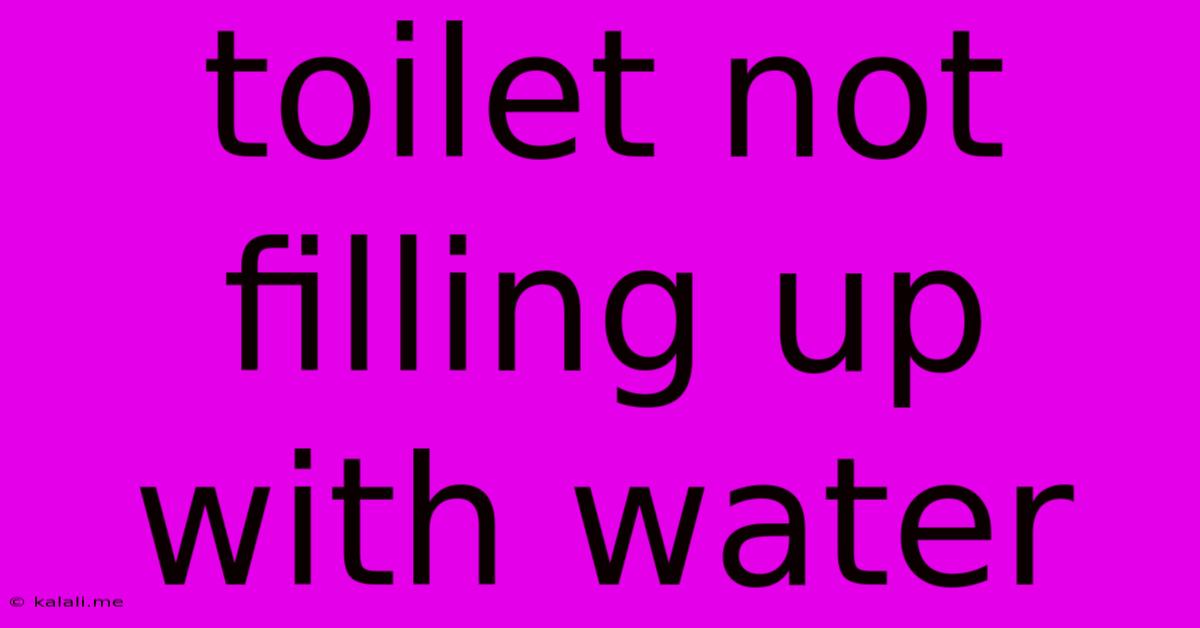Toilet Not Filling Up With Water
Kalali
May 23, 2025 · 4 min read

Table of Contents
Toilet Not Filling Up With Water? Troubleshooting Guide
A toilet that won't fill with water is a frustrating plumbing problem, leaving you with a non-functional fixture. This comprehensive guide will walk you through troubleshooting common causes and offer solutions, saving you potential plumbing repair costs. Understanding the simple mechanics of your toilet will empower you to fix this issue quickly and efficiently.
Identifying the Problem: No Water in the Bowl or Tank?
Before diving into solutions, it's crucial to determine the exact nature of the problem. Are you experiencing a complete lack of water in both the bowl and the tank? Or is the water only absent from the bowl after flushing? This distinction helps narrow down the potential causes.
Common Causes and Solutions:
1. Low Water Supply:
- Problem: The most common reason for a toilet not filling is insufficient water pressure. This can be due to low water pressure throughout the house, or a problem specifically with the toilet's water supply line.
- Solution: Check your house's main water supply. Is water flowing normally from other taps? If not, you may need to contact your water company. If other taps work fine, examine the water supply line to your toilet. Look for kinks, clogs, or loose connections. Tighten any loose connections and replace any damaged lines. The shut-off valve behind the toilet might also be turned off; check and turn it on if necessary.
2. Clogged Fill Valve:
- Problem: The fill valve is responsible for refilling the toilet tank after flushing. Mineral deposits, debris, or a faulty valve can prevent it from functioning correctly.
- Solution: Turn off the water supply to the toilet. Carefully remove the tank lid and examine the fill valve. Look for any visible obstructions. You can try cleaning the valve with a brush or by soaking it in vinegar to remove mineral deposits. If the valve is severely damaged or the problem persists, you'll likely need to replace the fill valve entirely. This is a relatively inexpensive and easy DIY repair.
3. Malfunctioning Float:
- Problem: The float is a ball or cup that controls the water level in the tank. If the float is damaged, it may not rise to the correct level, preventing the fill valve from closing.
- Solution: Check the float. If it's cracked, leaking, or otherwise damaged, replace it. A simple adjustment might be enough, depending on the type of float. Sometimes a small piece of debris can prevent it from rising.
4. Broken Chain or Flapper:
- Problem: Although this doesn't directly prevent filling, a broken chain or a constantly open flapper will cause the tank to constantly drain, leaving you with little to no water.
- Solution: Inspect the chain connecting the handle to the flush lever. Ensure it is properly attached and not tangled. If the flapper is not sealing properly, it might need adjustment or replacement. A simple fix involves checking for wear and tear and replacing if necessary.
5. Clogged Toilet Supply Line:
- Problem: Sediment buildup or debris within the supply line can restrict water flow to the tank.
- Solution: Turn off the water supply. Disconnect the supply line and flush out any debris. If the clog persists, you may need to replace the supply line entirely.
6. Water Level Too Low:
- Problem: The water level might be set too low, preventing the fill valve from completely filling the tank.
- Solution: Check your toilet's instructions. Often, there's a mechanism on the fill valve (a screw or clip) which can adjust the water level. Adjust the water level to the indicated height marked inside the tank.
7. Cracked Tank or Bowl:
- Problem: A hairline crack in the tank or bowl can cause a slow leak, gradually reducing the water level.
- Solution: Carefully inspect the toilet tank and bowl for any cracks. If a crack is found, unfortunately, replacing the toilet is usually the best option.
When to Call a Plumber:
While many of these issues can be resolved with simple DIY repairs, there are instances where professional help is needed. If you're uncomfortable working with plumbing, or if you've tried these troubleshooting steps and the problem persists, contacting a licensed plumber is the best course of action. Ignoring a persistent plumbing issue can lead to more significant and costly problems down the line.
By carefully following these steps and understanding the basic mechanics of your toilet, you can effectively troubleshoot and often resolve the problem of a toilet not filling with water, saving time and money in the process. Remember safety first – always turn off the water supply before attempting any repairs.
Latest Posts
Latest Posts
-
How Long Can Gas Sit In A Gas Can
May 25, 2025
-
How To Get Rid Of Dog Urine Smell In Carpet
May 25, 2025
-
What Do You Want To Do
May 25, 2025
-
Which Of The Following Is Correct
May 25, 2025
-
The Kingdom Of Heaven Suffers Violence
May 25, 2025
Related Post
Thank you for visiting our website which covers about Toilet Not Filling Up With Water . We hope the information provided has been useful to you. Feel free to contact us if you have any questions or need further assistance. See you next time and don't miss to bookmark.